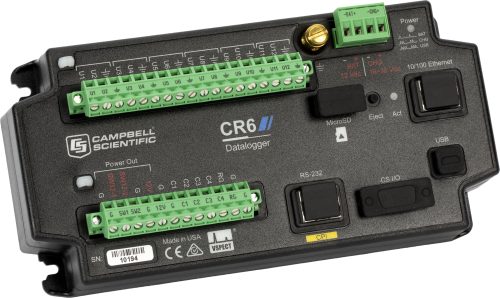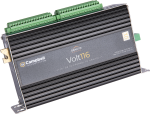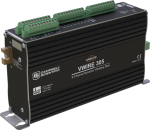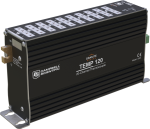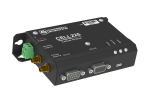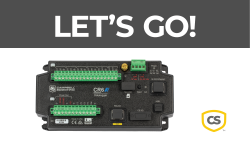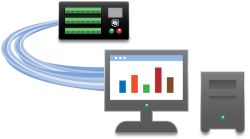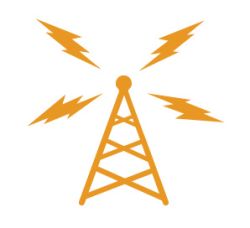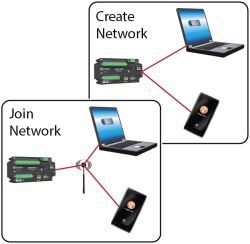Visão Geral
O registrador de dados (datalogger) CR6 é uma ferramenta de alto desempenho para medição e controle sendo o componente principal do seu sistema de aquisição de dados. O datalogger CR6 fornece comunicação rápida, com baixo consumo de energia, porta USB embutida, tamanho compacto e alta capacidade de precisão e resolução nas portas analógicas. O CR6 possui terminais universais (U) para permitir a conexão com praticamente qualquer sensor - analógico, digital ou inteligente. Um registrador de dados multiuso e com grande capacidade de executar medições estáticas de sensores de cordas vibrantes.
O CR6 pode incluir opções de rádio integradas:
- CR6-RF427: 900 MHz (Brasil)
- CR6-451: 900 MHz, 1 W (Estados Unidos, Canadá e Austrália)
- CR6-WIFI: 2.4 GHz
Benefícios e Características
- Operacional em ambientes extremos com um padrão faixa de operação de -40 ° a + 70 °C e uma operação prolongada com faixa de -55°C a + 85°C
- Conexão direta com à porta USB do computador
- Terminais U configuráveis de acordo com o seu projeto: analógico ou digital, entrada ou saída
- Suporta medições estáticas de sensores de cordas vibrantes usando a tecnologia de análise espectral patenteada VSPECT™
- Diferencia até pequenas alterações nos valores dos dados com medições de alta resolução (para 0,05 µV, 24 bits Adc)
- Possui uma porta CPI integrada para hospedar sensores de alta velocidade Campbell e módulos distribuídos (CDM)
- Conecta-se diretamente à Ethernet com 10/100 Ethernet RJ-45 ou Ethernet por USB (Ethernet virtual)
- Inclui entrada para cartão microSD para expansão da memória e requisitos
- Provides simple serial sensor integration and measurement with SDI-12, RS-232, and/or RS-485
- Suporte completo para rede PakBus®
- Inclui página da web incorporada para conexão direta via navegador de rede
Produtos Relacionados
Descrição Técnica
O CR6 mede quase todos os sensores com resposta elétrica, direciona as comunicações diretas e telecomunicações, reduz os dados a valores estatísticos, realiza cálculos e controla dispositivos externos. Depois de são feitas medições, os dados são armazenados na memória interna (não volátil) e assim guarda os dados para transferência com seu computador. Como a maioria das aplicações não exige que todas as medições sejam registradas, o programa geralmente combina várias medições em resumos computacionais ou estatísticos, como médias e desvios padrão.
Opções de Comunicação
A opção CR6-WIFI
O CR6-WIFI é a solução ideal para comunicação via IP em comunicações de curto alcance.
Usando um dispositivo habilitado para Wi-Fi e nosso aplicativo móvel gratuito LoggerLink, você pode conectar-se sem fio ao CR6-WIFI. O CR6-WIFI vem configurado de fábrica como um ponto de acesso Wi-Fi. Como alternativa, o CR6-WIFI pode ser configurado para ingressar em uma rede Wi-Fi existente com segurança padrão ou corporativa (EAP).
A opção CR6-RF427
O CR6-RF427 é ideal para rádios de médio alcance e sem licença comunicações.
A opção de rádio frequency-hopping spread-spectrum de 900 MHz e 250 mW pode ingressar em uma rede de rádio de "topologia em malha" de alta velocidade com outros registradores de dados usando o rádio RF427 incluído.
A opção CR6-RF451
O CR6-RF451 é normalmente usado para comunicações de rádio de longo alcance e sem licença. Com essa opção de rádio frequency-hopping spreadspectrum de 900 MHz, 1 W, o CR6-RF451 pode fazer parte de uma rede de "topologia em estrela", na qual todo o tráfego do RF é encaminhado através do mestre. Pode funcionar em rede com outros dispositivos usando rádios RF450 ou RF451. O CR6-RF451 pode ser configurado como um dispositivo mestre, repetidor ou remoto e pode estar localizado a quilômetros de distância em ambientes adversos ao RF.
Compatibilidade
Please note: The following shows notable compatibility information. It is not a comprehensive list of all compatible products.
Software
| Product | Compatible | Note |
|---|---|---|
| DevConfig | (Version 2.10 or higher) | |
| LoggerLink | (Version 1.3 or higher) | |
| LoggerNet | (Version 4.3 or higher) | |
| LoggerNet Mobile Connect | (Version 1.0 or higher) | |
| PC400 | (Version 4.3 or higher) | |
| RTDAQ | (Version 1.2 or higher) | |
| Short Cut | (Version 3.1 or higher) |
Additional Compatibility Information
Sensors
With several terminal types, the CR6 is compatible with nearly every available sensor, including analog (both voltage and current), thermocouples, serial, SDI-12, vibrating wire, pulse, and frequency sensors.
Measurement and Control Peripherals
The CR6 is compatible with all CDMs, multiplexers, vibrating wire interfaces, terminal input modules, and relays.
Communications
The CR6 communicates with a PC via direct USB port, 10/100baseT Ethernet port, Wi-Fi, multidrop modems, short-haul modems, phone modems (land-line, digital cellular, and voice-synthesized), RF telemetry, and satellite transmitters (HDR GOES, Argos, Meteosat, Iridium, and Inmarsat).
Data can be viewed on an iOS or Android device.
| Data Logger Option | Radio Type | Integrated Radio Is Over-the-Air Compatible With |
|
CR6-WIFI |
2.4 GHz, 20 MHz bandwidth |
Most other Wi-Fi devices, such as the CR310-WIFI, CR300-WIFI, CR350-WIFI, NL241 |
|
CR6-RF407 |
902 to 928 MHz Frequency Hopping Spread Spectrum |
RF407, CR300-RF407, CRVW3-RF407, CR350-RF407 |
|
CR6-RF412 |
915 to 928 MHz Frequency Hopping Spread Spectrum |
RF412, CR300-RF412, CRVW3-RF412 , CR350-RF412 |
|
CR6-RF422 |
868 MHz SRD860 LBT+AFA |
RF422, CR300-RF422, CRVW3-RF422, CR350-RF422 |
|
CR6-RF452 |
902 to 928 MHz, 1 W Frequency Hopping Spread Spectrum |
RF450, RF451, RF452, CR6-RF451, CR350-RF452 |
Enclosures
The CR6 and its power supply can be housed in any of our standard enclosures.
Power
The CR6 uses an external power source and has a built-in charger/regulator. Intelligent power sourcing autoselects the highest voltage from three input sources (CHG, BAT, or USB) to operate in one of the following four modes:
- UPS (recommended)—A 16 to 32 Vdc source, solar panel (SP10, SP20), or power converter is used to charge a 12 Vdc battery, such as our BP7, BP12, or BP24.
- 12 Vdc battery or other reliable 12 Vdc source
- Charge only—dc power supply (16 to 32 Vdc)
- USB—Powered over 5 Vdc USB port for setup, programming, and testing (will not charge battery or boost USB power to provide 12 Vdc to the SW12 switched battery terminals or the 12V power output terminal)
Software
CRBasic, the CR6's full programming language, supports simple or complex programming and many on-board data reduction processes. The CR6 is compatible with CRBasic (version 3.5 or higher).
Especificações
| -NOTA- |
|
| Faixa de Temperatura Operacional |
|
| Material da Caixa | Resistente a alto impacto em policarbonato, resistente ao UV-TPE, código de reciclagem 7 |
| Entradas Analógicas | 12 entradas configuradas individualmente para funções analógicas ou digitais |
| Contadores de Pulsos | 16 16 (C1 a C4 e U1 a U12) |
| Portas de Comunicação |
|
| Portas de Armazenamento de Dados | microSD |
| Porta Chaveada 12V | 2 terminals |
| I/O Digital | 16 terminais (C1 a C4, U1 a U12) configuráveis para entrada e saída digital. Os terminais são configuráveis em pares para lógica de 5 V ou 3,3 V para algumas funções. |
| Limites de Entrada | ±5 V |
| Precisão de Tensão Analógica |
|
| ADC | 24-bit |
| Charge Terminal Characteristics (CHG+ and CHG-) |
|
| Battery Terminal Characteristics (BAT+ and BAT-) |
|
| Precisão do Relógio em Tempo Real | ±3 min. por ano (correção GPS opcional para ±10 µs) |
| Protocolos de Internet | Ethernet, PPP, IP de E / S CS, RNDIS,ICMP / Ping, IP automático (APIPA), IPv4, IPv6, UDP, TCP, TLS (v1.2), DNS, DHCP, SLAAC, SNMPv3, NTP, Telnet, HTTP (S), FTP (S), SMTP / TLS, POP3 / TLS |
| Protocolos de Comunicação | CPI, PakBus, SDM, SDI-12, Modbus, TCP, DNP3, UDP, NTCIP, NMEA 0183, I2C, SPI, e outros |
| SRAM com Bateria para Uso da CPU e Armazenamento Final | 4 MB |
| Armazenamento de Dados | SRAM de 4 MB + flash de 72 MB (expansão de armazenamento de até 16 GB com cartão de memória com micros flash removível.) |
| Consumo de Corrente Ocioso |
|
| Consumo de Corrente Médio |
|
| Medições Estáticas de Sensores de Cordas Vibrantes | Suportada |
| Dimensões |
21,0 x 10,2 x 5,6 cm (8,3 x 4,0 x 2,2 in.) Espaço adicional necessário para cabos e condutores |
| Peso | 0,42 a 0,52 kg (0,92 a 1,15 lb) Dependendo da comunicação opcional selecionada |
Opção CR6-RF427 |
|
| Tipo de Rádio | Frequency Hopping Spread Spectrum (FHSS) |
| Potência de Saída | 5 a 250 mW (selecionável pelo usuário) |
| Frequência | 902 a 907,5 MHz / 915 a 928 MHz (Brasil) |
| Taxa de Dados de RF | 200 kbps |
| Receber Sensibilidade | –101 dBm |
| Conector da Antena | RPSMA (antena externa requerida.) |
| Consumo de Corrente Ocioso | 12 mA (@ 12 Vdc) |
| Consumo de Corrente Médio | < 80 mA (@ 12 Vdc) |
Opção CR6-RF451 |
|
| Tipo de Rádio | Frequency Hopping Spread Spectrum (FHSS) |
| Potência de Saída | 10 a 1,000 mW (selecionável pelo usuário) |
| Frequência | 902 a 928 MHz |
| Taxa de Dados de RF | 115,2 ou 153,6 kbps (selecionável pelo usuário) |
| Receber Sensibilidade |
|
| Conector da Antena | RPSMA (antena externa requerida; veja www.campbellsci.com/order/rf451 para antenas da Campbell Scientific.) |
| Consumo de Corrente Ocioso | 15 mA máximo (@ 12 Vdc) |
| Consumo de Corrente Médio | 650 mA máximo (@ 12 Vdc) |
Opção CR6-WIFI |
|
| Modos Operacionais | Client ou Access Point |
| Frequência de Operação | 2.4 GHz, 20 MHz bandwidth |
| Conector da Antena | RPSMA |
| Antenna | pn 16005 ganho de unidade (0 dBd), ½ onda, omnidirecional com articulação para orientação vertical ou horizontal |
| Potência de transmissão | 7 a 18 dBm (5 a 63 mW) |
Documentos Relacionados
Lâminas do produto
Manuais
Trabalhos técnicos
- CR6-WiFi Daughter Board OS Update Procedure to Resolve the KRACK Vulnerability
- FTP Streaming
- DNP3 with Campbell Scientific Dataloggers
- Measuring a PRT or Thermistor without a Completion Resistor
- FTP Troubleshooting
- Modbus Troubleshooting Guide
- HTTP Troubleshooting
- Modbus: Using Campbell Scientific Dataloggers as Modbus Slave Devices in a SCADA Network
- Using MQTT with Campbell Scientific Data Loggers
Conformidade
- CR6 and 33205 EU Declaration of Conformity
- CR6 and 33205 UK Declaration of Conformity
- CR6-RF407 FCC Supplier Declaration of Conformity and FCC Statement
- CR6-RF422 EU Declaration of Conformity
- CR6-RF422 UK Declaration of Conformity
- RF427 Brazilian Certificate of Conformity
- CR6-WIFI EU Declaration of Conformity
- CR6-WIFI UK Declaration of Conformity
- CR6-WIFI FCC Supplier Declaration of Conformity and FCC Statement
Videos & Tutoriais
Downloads
CR6 Web Browser Interface v.1.2 (801 KB) 13-09-2024
Standard Datalogger Web Browser Interface
Use this download to update the dataloggers web browser interface.
To install this file, send it to the datalogger using file control found in the Device Configuration Utility or file control found in LoggerNet.
This interface is recommended for fast IP interfaces like Ethernet and WiFi. It does NOT perform well over slow communications mediums like cellular.
Note: This is NOT for system dataloggers that have custom interfaces like the SunSentry, Hydro-Link, Alert205, and MeteoPV.
CR6 OS v.14.4.0 (9.02 MB) 16-09-2025
This download is for the CR6 datalogger. Execution of this download places the current CR6 Operating System file(.obj) and WiFi, RF45x and RF4xx operating systems (iobj) on your computer. It also updates the CRBasic Editor compiler and support files.
Why Update? New features and bug fixes. With this OS update it is recommended that you also update the Device Configuration Utility to the most recent version so that new datalogger features are available in the utility.
Note: Campbell Scientific always recommends updating operating systems on site if possible. When remote updates are required, it is recommended that you implement the necessary precautions to handle unexpected OS upload complications. All datalogger settings should be retained when updated remotely. If you choose to roll back to a previous operating system, the datalogger settings will be reset to default.
Watch the Video Tutorial: Sending an OS to a Local Datalogger.
CR6 RF45x OS Update v.4.01 (438 KB) 19-11-2024
This CR6-RF45x Series OS update is for the following:
- CR6-RF451
- CR6-RF452
Use the Device Configuration Utility to perform this update.
Device Configuration Utility v.2.33 (49.6 MB) 07-07-2025
A software utility used to download operating systems and set up Campbell Scientific hardware. Also will update PakBus Graph and the Network Planner if they have been installed previously by another Campbell Scientific software package.
Supported Operating Systems:
Windows 11 or 10 (Both 32 and 64 bit)
CR6 RF407 Series OS Update v.2.0 (430 KB) 03-07-2019
This CR6-RF407 Series OS update is for the following:
- CR6-RF407
- CR6-RF412
- CR6-RF422
- CR6-RF427
Use the Device Configuration Utility to perform this update.
Note: This is not for the CR6-RF451.
CR6 Wifi OS Update v.5.03 (2.23 MB) 21-05-2021
CR6 Wi-Fi OS update. This download includes the OS and the update procedure.
Custom Menu Example Program for Connections Video v.1 (1 KB) 26-03-2024
This program demonstrates creating a custom menu for data logger displays and corresponds to the Campbell Connections video: Creating Custom Menus in CRBasic for a Data Logger Display.
Data Logger Wiring Excel Template (1 KB) 26-03-2024
This is a data logger wiring diagram spreadsheet template that accompanies the Wiring Diagram Video. The spreadsheet includes templates for CR6, CR1000X, CR300, CR310, and CR350 data loggers. The file is an Excel template and works best with Microsoft Excel.
Perguntas Frequentes Relacionadas
Number of FAQs related to CR6: 9
Expandir todosRecolher todos
-
If a CPI-enabled device is running and there are skipped scans in the data logger, what can be done?
The default CPI bus speed setting is 250 kB/s. The speed is adjustable in your CRBasic data logger program. Use the CPISpeed() instruction in your CRBasic program to adjust the CPI bus bandwidth to meet the following maximum combined (total) Ethernet cable lengths:
- 1000 kB/s for maximum combined Ethernet cable lengths of 15.2 m (50.0 ft)
- 500 kB/s for maximum combined Ethernet cable lengths of 61.0 m (200.0 ft)
- 250 kB/s for maximum combined Ethernet cable lengths of 152.4 m (500.0 ft)
-
The potential transformer and the current transformer provide differential outputs that have galvanic isolation from the voltage and current in the circuit they are measuring. However, there is no need to run the outputs of these transformers into differential inputs of the data logger and unnecessarily consume additional data logger channels. We conducted extensive testing for noise immunity, for inaccuracies from ground loops, and more before concluding that single-ended measurements in the ACPower() instruction have the same performance as differential measurements would provide. Please note that as a result of the galvanic isolation of the potential transformer and current transformer, the data logger ground is NOT connected to the ground of the circuit they are measuring.
Said differently, you can connect differential outputs of a sensor to single-ended inputs of the data logger. However, doing so creates the possibility of poor common-mode noise rejection in the data logger and the possibility of introducing inaccuracies from ground loops between the sensor and the data logger. Note that in this application, the transformer isolation of the potential transformer and the current transformer eliminates these concerns.
Simply connect one of the potential transformer secondary wires and one of the current transformer secondary wires to the data logger ground. Which wire in either case makes a difference, as the phase information allows the measurement of power flowing in either direction. If you measure negative real power when it should be positive, then reverse the secondary wires of the potential transformer where they connect to the data logger. Alternatively, you can reverse the secondary wires on the current transformer, but don't reverse both pairs of wires.
-
A practical maximum is to connect one multiplexer per every two control terminals on the data logger. Control terminals can be shared between multiplexers to increase the number of connected multiplexers. Sharing terminals, however, requires more complex wiring and programming. Users who would like to connect more than one multiplexer per every two control terminals are advised to contact a sales or support engineer at Campbell Scientific for assistance.
-
The CR6 has true RS-232 levels on the RJ45 (CPI), and the data logger can be programmed for RS-232 levels on C1-C2 and C3-C4.
-
When idle, the CR1000, CR6, and CR1000X consume less than 1 mA @ 12Vdc. Similar to the CR6, the CR1000X has a much faster processor that requires more power when up and running. As such, there will be higher current draws during active measurements, serial communications, or when plugged into a PC via USB or Ethernet.
It may be helpful to think of the CR6 and CR1000X as being built on the same "platform."
-
Campbell Scientific sells, and embeds in their products, microSD cards that have single-level cell (SLC) memory. In contrast, many electronics retailers sell microSD cards that have multi-level cell (MLC) memory. The difference between these two types of memory is significant.
- The SLC microSD cards from Campbell Scientific are better suited for industrial and environmental applications where wide operating temperatures, low power consumption, and longevity are very important. Most SLC memory cards are designed with industrial applications in mind and, therefore, often have additional perks such as enhanced protection from ESD (electrostatic discharge) and mechanical damage.
- The MLC microSD cards commonly available at electronics retailers are less expensive, but they are generally not well suited for the majority of applications in which Campbell Scientific data acquisition products are used.
-
Yes. The communications tasks run independently of each other, and multiple computers can be connected at the same time. If PakBus is being used to communicate, ensure that the computers are using different PakBus addresses to communicate to the data logger.
-
The serial modem can be connected to a CR6 using any of the following methods:
- Connect the modem to the RS-232/CPI port on the CR6 using cable pn 31055 (RS-232/CPI RJ45 to DB9 Pin [Male] DTE).
- Connect the modem to the RS-232/CPI port on the CR6 using cable pn 31056 (RS-232/CPI RJ45 to DB9 Socket [Female] DCE).
- Connect the modem to a C or U terminal pair on the CR6, where the pair has been configured for serial I/O.
- Connect the modem to the CS I/O port on the CR6 using an SC105.
Estudos de Caso
In the mountains of Antioquia, Colombia, eight of the region’s most important dams now share......Leia mais
Overview The Udhampur-Srinagar-Baramulla Rail Link (USBRL) project is of national importance as it connects Kashmir to the......Leia mais
The Expressway S19 represents a critical link in Europe’s transportation network, stretching 570 km (354.2......Leia mais
Understanding the spatial variability of the Earth’s atmospheric boundary layer—including the surface layer near the......Leia mais
Overview The reconstruction of the navigational lock system at the Iron Gate I Hydroelectric Power Station......Leia mais
The Homestake Neutrino Experiment—also referred to as the “Davis Experiment” after physicist Ray Davis, who......Leia mais
In the intricacies of transportation networks, bridges take center stage, knitting together communities and ensuring......Leia mais
Background Think of the First Transcontinental Railroad. Minor errors in surveys and maps could have led......Leia mais
Artigos e Comunicados de Imprensa
Newsletter
- Coming Soon: New CPEC300-Series Closed-Path Eddy-Covariance Systems 24-01-2018
- CR6 Upgrade 15-11-2017
- New Communication Options for Our CR6 and CR300 Dataloggers 16-01-2017
- New Radio Options for CR300 and CR6 Dataloggers 28-10-2016
- Case Study: Buoy System in Costa Rica 21-07-2016
- CR6-RF451 Available Soon 18-04-2016
- Case Study: Hydro-SCADA System in Northern California 18-04-2016
- CR6 Now Has Wi-Fi Option 02-02-2016
- New Operating System for the CR6 15-10-2015
- Novel Application of Measurement and Control Capabilities of CR6 15-10-2015
- New CR6 Datalogger 20-10-2014
